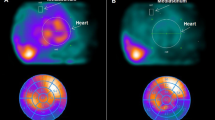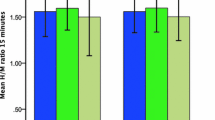Abstract
Background
Cardiac autonomic dysfunction as assessed by 123I-metaiodobenzylguanidine (123I-mIBG) scintigraphy is associated with poor prognosis in heart failure (HF) patients. Although cardiac resynchronization therapy (CRT) has emerged as an effective therapy in improving outcomes on HF patients, its effect on cardiac sympathetic nervous function is still not fully understood. We aimed to study the value of pre-implantation 123I-mIBG late heart-to-mediastinum ratio (HMR) as a predictor of response and outcomes after CRT and to correlate modification in this parameter with CRT response and functional improvement.
Methods and Results
BETTER-HF (Benefit of exercise training therapy and cardiac resynchronization in HF patients) is a prospective randomized clinical trial including HF patients submitted CRT (mean LVEF 24 ± 8%, 74% NYHA class ≥ III) who underwent a clinical, echocardiographic, and scintigraphic assessment before and 6 months after CRT. One-hundred and twenty-one patients were included. Echocardiographic response was observed in 54% and composite outcome of cardiac mortality, cardiac transplant or heart failure hospitalization in 24% of patients. Baseline late HMR was an independent predictor of CRT response (regression coefficient 2.906, 95% CI 0.293-3.903, P .029) and outcomes (HR 0.066 95% CI 0.005-0.880, P .040). At follow-up, 123I-mIBG imaging showed positive changes in cardiac sympathetic nerve activity only in responders to CRT (1.36 ± 0.14 prior vs. 1.42 ± 0.16 after CRT, P .039). There was a significant correlation between improvement in late HMR and improvement in peak oxygen consumption (r 0.547, P < .001).
Conclusion
In our study, baseline cardiac denervation predicted response and clinical outcomes after CRT implantation. Cardiac sympathetic function was improved only in patients who responded to CRT and these positive changes were correlated with improvement in functional capacity.

Similar content being viewed by others
Abbreviations
- HF:
-
Heart failure
- 123I-mIBG:
-
123I-metaiodobenzylguanidine
- HMR:
-
Heart-to-mediastinum ratio
- CRT:
-
Cardiac resynchronization therapy
- LVEF:
-
Left ventricular ejection fraction
- LVESV:
-
Left ventricle end-systolic volume
- VO2:
-
Oxygen consumption
- BNP:
-
Brain natriuretic peptide
- Hs-CRP:
-
High-sensitive C-reactive protein
References
Leimbach WN, Wallin BG, Victor RG, Aylward PE, Sundlöf G, Mark AL. Direct evidence from intraneural recordings for increased central sympathetic outflow in patients with heart failure. Circulation 1986;73:913-9.
Packer M. The neurohormonal hypothesis: A theory to explain the mechanism of disease progression in heart failure. J Am Coll Cardiol 1992;20:248-54.
Jacobson AF, Senior R, Cerqueira MD, Wong ND, Thomas GS, Lopez VA, et al. Myocardial iodine-123 meta-iodobenzylguanidine imaging and cardiac events in heart failure. Results of the prospective ADMIRE-HF (AdreView Myocardial Imaging for Risk Evaluation in Heart Failure) study. J Am Coll Cardiol 2010;55:2212-21.
Anastasiou-Nana MI, Terrovitis JV, Athanasoulis T, Karaloizos L, Geramoutsos A, Pappa L, et al. Prognostic value of iodine-123-metaiodobenzylguanidine myocardial uptake and heart rate variability in chronic congestive heart failure secondary to ischemic or idiopathic dilated cardiomyopathy. Am J Cardiol 2005;96:427-31.
Bristow MR, Saxon LA, Boehmer J, Krueger S, Kass DA, De Marco T, et al. Cardiac-resynchronization therapy with or without an implantable defibrillator in advanced chronic heart failure. N Engl J Med 2004;350:2140-50.
Cleland JG, Daubert JC, Erdmann E, Freemantle N, Gras D, Kappenberger L, et al. The effect of cardiac resynchronization on morbidity and mortality in heart failure. N Engl J Med 2005;352:1539-49.
Tang ASL, Wells GA, Talajic M, Arnold MO, Sheldon R, Connolly S, et al. Cardiac-resynchronization therapy for mild-to-moderate heart failure. N Engl J Med 2010;363:2385-95.
Cruz MC, Abreu A, Portugal G, Santa-Clara H, Cunha PS, Oliveira MM, et al. Relationship of left ventricular global longitudinal strain with cardiac autonomic denervation as assessed by123I-mIBG scintigraphy in patients with heart failure with reduced ejection fraction submitted to cardiac resynchronization therapy: Assessment of cardiac autonomic denervation by GLS in patients with heart failure with reduced ejection fraction submitted to CRT. J Nucl Cardiol 2017. https://doi.org/10.1007/s12350-017-1148-9.
Lang RM, Badano LP, Mor-Avi V, Afilalo J, Armstrong A, Ernande L, et al. Recommendations for cardiac chamber quantification by echocardiography in adults: An update from the American society of echocardiography and the European association of cardiovascular imaging. Eur Heart J Cardiovasc Imaging 2015;16:233-71.
Nagueh SF, Smiseth OA, Appleton CP, Byrd BF, Dokainish H, Edvardsen T, et al. Recommendations for the evaluation of left ventricular diastolic function by echocardiography: An update from the American Society of Echocardiography and the European Association of Cardiovascular Imaging. J Am Soc Echocardiogr 2016;29:277-314.
Boidol J, Średniawa B, Kowalski O, Szulik M, Mazurek M, Sokal A, et al. Many response criteria are poor predictors of outcomes after cardiac resynchronization therapy: Validation using data from the randomized trial. Europace 2013;15:835-44.
Zucker IH, Wang W, Pliquett RU, Liu JL, Patel KP. The regulation of sympathetic outflow in heart failure. The roles of angiotensin II, nitric oxide, and exercise training. Ann N Y Acad Sci 2001;940:431-43.
Kaye DM, Lefkovits J, Jennings GL, Bergin P, Broughton A, Esler MD. Adverse consequences of high sympathetic nervous activity in the failing human heart. J Am Coll Cardiol 1995;26:1257-63.
Schofer J, Spielmann R, Schuchert A, Weber K, Schlüter M. Iodine-123 meta-iodobenzylguanidine scintigraphy: A noninvasive method to demonstrate myocardial adrenergic nervous system disintegrity in patients with idiopathic dilated cardiomyopathy. J Am Coll Cardiol 1988;12:1252-8.
Imamura Y, Ando H, Mitsuoka W, Egashira S, Masaki H, Ashihara T, et al. Iodine-123 metaiodobenzylguanidine images reflect intense myocardial adrenergic nervous activity in congestive heart failure independent of underlying cause. J Am Coll Cardiol 1995;26:1594-9.
Verberne HJ, Brewster LM, Somsen GA, Van Eck-Smit BLF. Prognostic value of myocardial 123I-metaiodobenzylguanidine (MIBG) parameters in patients with heart failure: A systematic review. Eur Heart J 2008;29:1147-59.
Nishioka SADO, Martinelli M, Brandão SCS, Giorgi MC, Vieira MLC, Costa R, et al. Cardiac sympathetic activity pre and post resynchronization therapy evaluated by 123I-MIBG myocardial scintigraphy. J Nucl Cardiol 2007;14:852-9.
Cha Y-M, Chareonthaitawee P, Dong YX, Kemp BJ, Oh JK, Miyazaki C, et al. Cardiac sympathetic reserve and response to cardiac resynchronization therapy. Circ Heart Fail 2011;4:339-44.
Curcio A, Cascini GL, De Rosa S, Pasceri E, Veneziano C, Cipullo S, et al. 123I-mIBG imaging predicts functional improvement and clinical outcome in patients with heart failure and CRT implantation. Int J Cardiol 2016;207:107-9.
Erol-Yilmaz A, Verberne HJ, Schrama TA, Hrudova J, De Winter RJ, Van Eck-Smit BLF, et al. Cardiac resynchronization induces favorable neurohumoral changes. Pacing Clin Electrophysiol 2005;28:304-10.
Burri H, Sunthorn H, Somsen A, Fleury E, Stettler C, Shah D, et al. Improvement in cardiac sympathetic nerve activity in responders to resynchronization therapy. Europace 2008;10:374-8.
Shinohara T, Takahashi N, Saito S, Okada N, Wakisaka O, Yufu K, et al. Effect of cardiac resynchronization therapy on cardiac sympathetic nervous dysfunction and serum C-reactive protein level. Pacing Clin Electrophysiol 2011;34:1225-30.
Cohen-Solal A, Esanu Y, Logeart D, Pessione F, Dubois C, Dreyfus G, et al. Cardiac metaiodobenzylguanidine uptake in patients with moderate chronic heart failure: Relationship with peak oxygen uptake and prognosis. J Am Coll Cardiol 1999;33:759-66.
Atsumi H, Takeishi Y, Fujiwara S, Tomoike H. Cardiac sympathetic nervous disintegrity is related to exercise intolerance in patients with chronic heart failure. Nucl Med Commun 1998;19:451-6.
De Milliano PAR, Van Eck-Smit BLF, Van Zwieten PA, De Groot AC, Tijssen JGP, Lie KI. Relationship between cardiac metaiodobenzylguanidine uptake and hemodynamic, functional and neurohormonal parameters in patients with heart failure. Eur J Heart Fail 2001;3:693-7.
Nakata T, Nakajima K, Yamashina S, Yamada T, Momose M, Kasama S, et al. A pooled analysis of multicenter cohort studies of 123I-mIBG imaging of sympathetic innervation for assessment of long-term prognosis in heart failure. JACC Cardiovasc Imaging 2013;6:772-84.
Alba AC, Adamson MW, MacIsaac J, Lalonde SD, Chan WS, Delgado DH, et al. The added value of exercise variables in heart failure prognosis. J Card Fail 2016;22:492-7.
Stefanelli A, Treglia G, Giordano A. (123)I-MIBG scintigraphy as a powerful tool to plan an implantable cardioverter defibrillator and to assess cardiac resynchronization therapy in heart failure patients. Int J Mol Imaging. 2012;2012:690468.
Disclosures
Rita Ilhão Moreira, Ana Abreu, Guilherme Portugal, Luís Oliveira, Mário Oliveira, Inês Rodrigues, Madalena Coutinho Cruz, Pedro Silva Cunha, Vanessa Santos, Helena Santa Clara, Rui Cruz Ferreira, Miguel Mota Carmo have no conflicts of interest to declare.
Author information
Authors and Affiliations
Corresponding author
Additional information
The authors of this article have provided a PowerPoint file, available for download at SpringerLink, which summarises the contents of the paper and is free for re-use at meetings and presentations. Search for the article DOI on SpringerLink.com.
Electronic supplementary material
Below is the link to the electronic supplementary material.
Rights and permissions
About this article
Cite this article
Moreira, R.I., Abreu, A., Portugal, G. et al. Prognostic effect and modulation of cardiac sympathetic function in heart failure patients treated with cardiac resynchronization therapy. J. Nucl. Cardiol. 27, 283–290 (2020). https://doi.org/10.1007/s12350-018-1357-x
Received:
Accepted:
Published:
Issue Date:
DOI: https://doi.org/10.1007/s12350-018-1357-x




